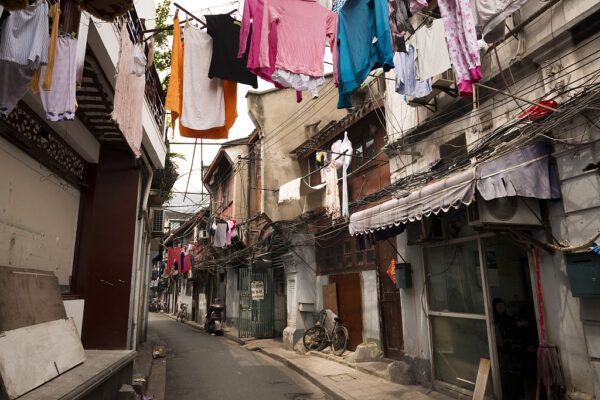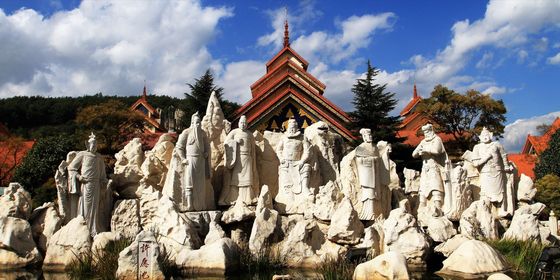A melodious and hybrid dialect shaped by a city’s storied past
For over a decade, The World of Chinese has been offering modern Chinese-language instruction from street talk to social phenomena to character tales. With 129 officially recognized dialects (方言), though, we have barely scratched the surface of everything there is to learn.
On select Fridays, TWOC will be presenting a basic lesson on speaking like a native of a certain region of China.
Few Chinese fangyan have undergone as dramatic a rise and decline as Shanghaiese. Once serving as a badge of honor for older Shanghai residents, and now nearly forgotten among the city’s younger generations, the sing-song dialect of zanhei wua (上海话) has been a linguistic mirror to centuries of cosmopolitan transformations.
Shanghaiese can be heard in the heart of Wu-speaking region of Jiangdong and Jiangnan. The Wu language family, which also includes the dialects of Shaoxing and Wenzhou, has about 81 million native speakers, slightly more than the nearly 77 million native French speakers around the world. Throughout Chinese history, different Wu dialects have served as the regional lingua franca, from the Jiaxing dialect in the Ming Dynasty, to the Suzhou dialect in the Qing Dynasty.

Shanghai’s Nanjing Road has been a bustling shopping district since 1845
The 20th century is considered the heyday of Shanghaiese. Though an older version of the dialect can be traced to the Southern Song Dynasty (1127-1279), the modern dialect evolved in the last 150 years alongside the growth of Shanghai as China’s center of commerce, adapting from a chimera of Wu dialects brought to the city by a massive influx of immigrants beginning in the mid-19th century.
Practically all speakers of Shanghaiese speak a hybrid strain—retaining a Ningbo or Suzhou flavor, for example. Some linguists to further delineate the dialect into neighborhood varieties: Pudong, Qingpu, Songjiang, Jiading, Chongming, Jinshan, Wujiang, and more.
As a result, it’s difficult to say what constitutes “pure” Shanghaiese. When the municipal government recruited local speakers for language preservation projects in 2010, it found “pure” Shanghaiese speakers at only two of 13 interview sites—despite a supposed 14 million speakers of the dialect.

Many older Shanghaiese grew up in communities made of longdang (弄堂), or “lane houses”
Today’s native speaker is Mrs. Zhuang, a woman in her 80s who grew up in the longtang of Hongkou district, Shanghai, to parents who migrated from Ningbo, Zhejiang. Zhuang’s sister’s grandson, a college student born and raised in Shanghai, can understand the dialect but cannot speak it, preferring instead to focus on English and German.
Whereas Shanghaiese was once nearly ubiquitous throughout the city, a national campaign to discourage the usage of dialects in schools and media in favor of Putonghua began in 1992, part of the government’s ambitions to strengthen national identity. The municipal government, however, has begun to push back against the extinction of their dialect in recent years. Some kindergartens and elementary schools now teach Shanghaiese.
A number of young people today are trying to integrate Shanghaiese into their lives. Singers cover popular songs in Shanghaiese (such as “Let it Go” from Frozen), and a handful of rappers like Mr. Weezy even write and record in the dialect. Although still rarely heard at the supermarket, perhaps the soft and lyrical Shanghai dialect is gearing for a comeback.
Here are a few basic features of the dialect:
- Shanghaiese, like many Wu dialects, retains some characteristics of Middle Chinese (spoken roughly between the fourth and 13th centuries) left behind by standard Putonghua: the older 吾 (ngú) is used for 我, and 勿 (ve) is used for 不.
- Shanghaiese has around 30 consonants (depending on the variety), more than Mandarin’s 24 consonants and Cantonese’s 17, including initial sounds absent in Mandarin such as [ng], [v], and the soft [z].
- Shanghaiese makes expressive use of onomatopoeias, especially in color adjectives: 蜡蜡黄 (la la wáng) for yellow, 碧碧绿 (be be ló) for green, 墨墨黑 (ma ma hā) for black.
- Some words are English cognates adopted in the late 19th and mid-20th century, amid the influx of foreign settlement and imported Western goods in the city: for example, 水门汀 (si mén tìng) sounds like “cement” in Shanghaiese.
- Most diphthongs (two-part vowels like “ao” in Mandarin), have been shortened into monopthongs or pure vowels, making the average Shanghaiese syllable shorter and quicker than Mandarin. For example, 老 “lǎo” becomes “ló.” This gives Shanghaiese its fast-paced staccato flow.
- To communicate degree, instead of 很, Shanghaiese makes use of 老. To indicate strong approval, Shanghaiese speakers would say 老赞 (ló zě).
- 这个女小囡长得像绿豆芽。
Ge ge nu xio nue zang de xiang lo do nga.
This little girl looks like a beansprout.
囡 (nān in Mandarin) is a rather archaic term for a small girl still prevalent in Wu dialects, where it’s pronounced like nue or nuai. 绿豆芽 suggests a lanky stature, like a beansprout.
2. 伊看起来戆大,其实门槛特别精。
Yi ku qi le gang du, ji ze meng ke de be jing.
He looks stupid, but in reality he’s very clever.
戆大 is slang for a “silly person.” Some trace its origins to the English word “gander,” a somewhat archaic slang for “silly goose.” 门槛, pronounced “meng ke,” is a cognate of the English word for “monkey.” To describe someone who is clever, or 精, as a simian, Shanghaiese often say 门槛精.
3. 伊工作寻着了,现在笃定了。
Yi gong ze xin ze le, yi ze do ding le.
He found a job, now he can rest assured.
In colloquial Shanghaiese, 寻着了 is used in place of Putonghua’s 找到了, and 笃定 is used in place of 放心.
4. 这个人瞎三话四。
Ge ga ning ha se wo si.
This person talks nonsense.
瞎三话四 is the Shanghaiese equivalent of 胡说八道 in Putonghua, an idiom meaning “to talk nonsense.”
5. 侬这个小鬼头不听话,我要拨侬吃生活。
Nong ge ga xio ju de ve ting e wo, ngo yo bo nong che sang wo.
You disobedient little demon, I’m going to teach you a lesson with my hands!
小鬼头 is a way to refer to a mischievous child. 吃生活, literally meaning “to eat life,” implies to give a beating. (Note: TWOC does not condone beating or threatening a child in any dialect.)












